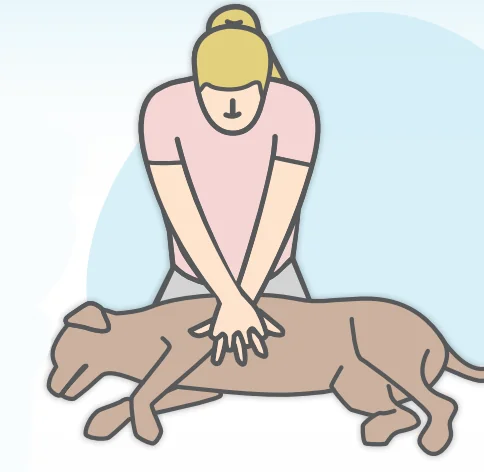Disclaimer: the blog post is intended to provide general advice only, and does not replace professional veterinary advice
Facing a pet emergency can be scary and overwhelming.
The mere thought of your furry friend in distress, especially when CPR becomes necessary, is a situation no dog parent wants to encounter.
That said, being prepared could make all the difference. In this blog post, we’ll arm you with crucial knowledge about canine CPR, transforming that panic into purposeful action.
How to Tell if Your Dog Needs CPR?
Spotting the signs of an emergency is the first step toward prompt action.
Your dog may need CPR if they’re unconscious and their heart has stopped, indicated by no signs of breathing, movement, or a pulse.
Other signs like excessive fatigue, sudden collapse, or persistent choking are serious and require immediate veterinary attention, but are not necessarily indicative of a need for CPR. For any kinds of cuts, bruises, and burns ensure you have a dog first aid kit ready.
You should always reach out to a veterinarian whenever you’re unsure – time is of the essence in such situations. Your knowledge, paired with their expertise, could be your pet’s best chance.
Where is Your Dog’s Heart Located?
Now, onto the basics of canine anatomy.
Your dog’s heart is located in the chest, nestled between the lungs. To find it, locate the point where your dog’s elbow meets the chest when the leg is folded. This point approximately marks the lower edge of the heart. A firm yet gentle touch in this area should enable you to feel the heartbeat.
This knowledge can be instrumental when it comes to delivering efficient chest compressions. Remember, precision could save precious seconds in an emergency.
The ABCs of Dog CPR
CPR, a life-saving technique, revolves around three fundamental elements, often referred to as the ABCs: Airway, Breathing, and Circulation.
Airway: In an emergency, first, ensure your dog’s airway is clear. Open the mouth, pull the tongue forward, and look for any potential obstructions. Remove any object in the mouth. However, if an object is firmly lodged and cannot be easily removed, it’s important not to try to force it out as this may push the object further down the throat or cause additional harm. In such cases, rush your pet to the vet immediately.
Breathing: Once the airway is clear, check for breathing by watching chest movements or feeling breaths against your hand. If there’s no breathing, rescue breaths become necessary.
Circulation: Feel for a heartbeat by placing your hand on the lower side of the rib cage, as explained earlier. If there’s no heartbeat, it’s time to start chest compressions.
Remember, CPR is a technique used when the heart stops beating, not a cure-all for every emergency. Always contact a veterinarian as soon as possible, even while performing CPR.
How to Perform CPR on Your Dog? (chest compressions)
Administering chest compressions is a crucial part of CPR. Here’s a step-by-step guide on how to do CPR on a dog:
- Lay your dog on a flat surface, right side down.
- Position yourself behind your dog’s back.
- Place one palm on the rib cage over the heart, as we identified earlier, and the other hand on top of the first.
- Apply firm and quick compressions, pushing down by about one-third to one-half of the chest depth.
- Aim for 100-120 compressions per minute – roughly to the beat of “Staying Alive” by the Bee Gees.
- If giving mouth-to-mouth, after every 30 compressions, give two rescue breaths (discussed in detail in the following section). Rescue breaths should take you about 5 seconds. So that’s 30-2-30-2-30… and so on.
Remember, it’s crucial not to apply too much pressure or to compress too quickly, as this could harm your dog. Lastly, this guide may vary based on your dog’s size and breed, so familiarize yourself with specifics related to your pet.

Should You Give a Dog Mouth-to-Mouth?
The decision to provide a dog with mouth-to-mouth, officially known as rescue breaths, depends on the situation. When performing CPR, if your dog isn’t breathing, rescue breaths can help supply their body with much-needed oxygen.
If your dog is not breathing, and you’ve already begun chest compressions, then mouth-to-mouth is recommended. It can provide much-needed oxygen to your dog. However, if performing mouth-to-mouth is hindering your ability to do consistent chest compressions, or if you’re not comfortable with it, prioritizing chest compressions is a valid approach.
Here’s a simplified method:
- Ensure the airway is clear, as explained in the ABCs of CPR.
- Close your dog’s mouth and extend their neck to straighten the airway.
- Cover their nose with your mouth and exhale, watching for the chest to rise.
- Give 2 rescue breaths
Now repeat the cycle:
- Administer another 30 chest compressions.
- Give 2 more rescue breaths.
While this sounds straightforward, remember that every second counts in an emergency. In many cases, focusing on chest compressions is more effective and less time-consuming than alternating between compressions and rescue breaths.
Suggested Read: Handling Common Dog Injuries
How Breed and Size Affects CPR
Remember, CPR for dogs isn’t a one-size-fits-all procedure. Depending on your pet’s size and breed, certain modifications may be necessary to ensure the effectiveness of the resuscitation efforts.
Small Dogs (under 30 lbs)
For our smaller companions, like Chihuahuas or Dachshunds, be gentle. The pressure applied during chest compressions should be less, given their delicate body structure.
Position your hand over the dog’s heart, which you’ll find in the lower half of the chest, behind the elbow of the front left leg. Be sure your pet is on a flat surface, preferably lying on their right side. This position allows for easier access to the heart and reduces the risk of causing additional injury.
Use your palm to deliver compressions, and don’t press down more than a third to a half of the chest depth.
Medium to Large Dogs (30 lbs and above)
For medium to large dogs, like Labradors or German Shepherds, more force is required for chest compressions due to their larger size. Ideally, these dogs should also be lying on their right side.
Use both hands to deliver compressions if needed, one over the other, and position them over the widest part of the chest, not over the heart. The chest should be compressed by one-third to one-half of its width.
Flat-Nosed Breeds (e.g., Bulldogs)
These breeds have unique respiratory anatomy, making rescue breaths a little trickier. When giving rescue breaths, seal both the dog’s nose and mouth with your mouth to ensure no air escapes.
For chest compressions, follow the guidelines of their size. Their chest compressions might be more effective if the dog is positioned on its back due to the typical broad chest of these breeds.
Here’s a table to refer that summarizes all this:
| Dog Size | Chest Compression Force | Chest Compression Position | Rescue Breath Method |
| Small (<30 lbs) | Light pressure | Dog lying on its right side, hand over the heart | Standard method |
| Medium to Large (30 lbs+) | More force | Dog lying on its right side, hands over the widest part of the chest | Standard method |
| Flat-Nosed Breeds | As per dog size | As per dog size | Seal both nose and mouth |
In all cases, knowing your pet’s anatomy and regular heartbeat can help make your efforts more effective in an emergency.
And remember, these are general guidelines. Always consult with your vet to understand the best approach for your specific dog. Practice makes perfect, and being prepared can save your pet’s life.
Remember: In an emergency, do what you can to get your dog the care they need and always aim to get them to a vet as soon as possible.
Nothing replaces professional veterinary care. Your quick actions could buy precious time, but always rush your pet to the vet immediately in any emergency situation. Be there, be calm, and be ready to act. You might just be your pet’s hero.
FAQs
Is CPR the same for all breeds of dogs?
CPR basics remain the same across dog breeds. However, the pressure applied during chest compressions and the positioning may vary depending on the dog’s size and breed. Refer to the guidelines above.
How do I know if my dog needs CPR?
Your dog might need CPR if they are unconscious, not breathing, and you can’t detect a heartbeat. Always contact a vet immediately in any emergency situation.
Can I hurt my dog by performing CPR?
While there’s a risk of injury when performing CPR, such as broken ribs, it’s a life-saving technique to use when the heart has stopped beating. The potential benefits outweigh the risks, however, never perform CPR on a healthy dog, or a dog whose heart is still beating.
What should I do after performing CPR on my dog?
After performing CPR, regardless of the outcome, take your dog to the vet immediately for a complete check-up and necessary treatment.
Alex, a passionate animal lover, has experience in training and understanding animal behavior. As a proud pet parent to two dogs and three cats, he founded AnimalReport.net to share insights from animal experts and expand his knowledge of the animal kingdom.




